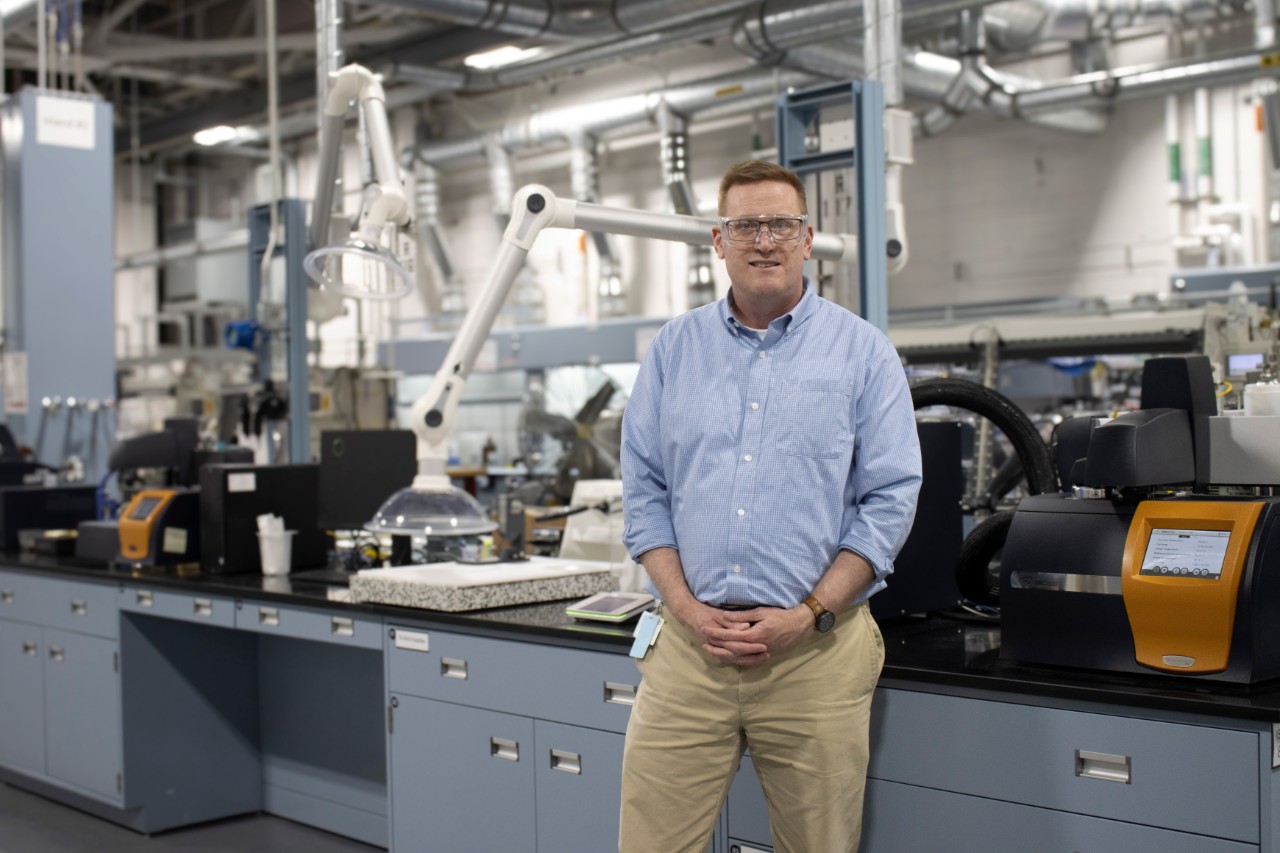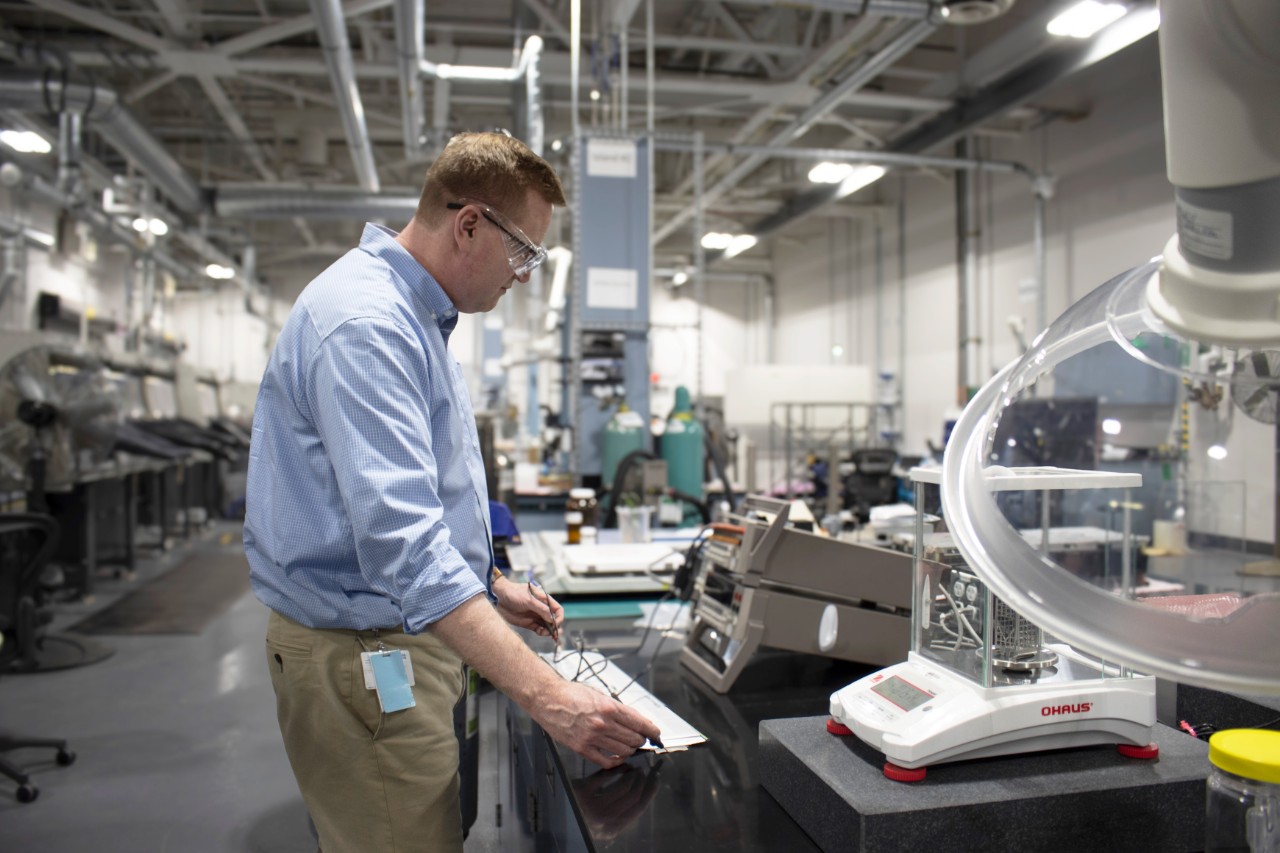By Jenn McKeogh, senior manager, GM News
General Motors analytical battery chemist Nick Irish was raised close to the automotive industry – literally. His childhood home sat on General Motors Road overlooking the Milford Proving Ground, GM's century-old hub for vehicle testing. As a child, he was constantly looking out his bedroom window, “wondering what happened over there.”
When his 11th grade class planned to visit the proving ground for a school field trip, he jumped at the chance.
“I got in huge trouble because I tried to get back on the bus when the field trip was over. I wanted to take another tour,” he laughs.
Irish was always interested in cars, and his deep desire to “know what the world was made of” led him in the direction of science. After high school, he earned a degree in chemistry from the University of Michigan.
Through those years, Irish never forgot how he excited he was to visit Milford. After graduation, he applied to work at General Motors and joined the company in 2001.
Irish started his career as an analytical chemist, focusing on research and development of fuel cells and EV battery technology. After 20 years in R&D, he wanted to make a change.
"I knew battery chemistry was a growth area, and I just had to be part of it,” Irish says. “I joined the labs and proving ground team in 2021 to do battery chemistry work, and that’s what I’m doing now.”
Analytical battery chemists Hayden Cunningham (left) and Adam Van Wiemeersch use a glove box to perform an electrolyte wash on a battery cell in the battery chemistry lab.
A look inside the lab
Irish now spends his days in GM’s battery chemistry lab, on GM’s Warren Tech Center campus in Michigan.
“I always joke that from the outside, you might think you’re walking past a broom closet. I don’t think a lot of people know all the cool things we do in here,” he says.
The 5,500-square foot lab is chock full of high-tech equipment - CT scanners, microscopes and glove boxes to maintain safety standards and preserve the integrity of battery samples – that the lab team uses to conduct tests on past, present and future battery technologies.
“Each day, we start with a list of EV battery cell parts and projects that need analysis. We assign out the work across the lab team, and then we dissect the cells,” he says. “Think of it like an autopsy lab for batteries – we figure out what they’re made of and investigate how we can make them better.”
Inorganic analytical chemist Ty Triplett calibrates a gas chromatograph in preparation to analyze battery gases
Irish and the lab team perform a variety of tests on battery cells, including using a CT scanner to look at cells micro-structurally, performing thermal analyses to determine chemical properties, and utilizing separation science to separate each chemical and analyze it.
“Imagine someone hands you, let’s say, a slice of pizza - and you want to deconstruct it into all its components to analyze the crust, sauce and cheese all separately,” says Irish. “That’s what we do with separation science.”
Batteries and beyond
The work that happens in the battery chemistry lab is vital to GM’s EV journey – but Irish says many people aren’t aware that there’s a whole world of chemistry in the automotive space. As he says, “it isn’t just for pharmaceuticals.”
“Chemistry is growing rapidly as a field, and one of the reasons is battery chemistry,” he says. “For decades, cars were made largely in the same way. It was all about reciprocal motion. But now, the future of automotive propulsion is all about chemistry.”
Outside of how much fun science is for chemists like Irish, he believes in the work happening in the chemistry lab and across GM’s footprint.
“This work is so important to secure a better future for me, and for my son,” Irish says. “I feel like I’m making an impact, and I can see it every day.”
On the job highlights the unique and innovative roles of employees across GM, from the unusual to the unexpected. If you have someone to nominate for this series, drop us a line at news@gm.com.
Check out more from the series:
· On the job: Max Sikorski, virtual reality lead
· On the job: David Craig, a master of maps
Learn more about GM’s battery technology by checking out these stories:
· What a battery geek learned in his first year at GM
· GM Ventures invests $10 million in Forge Nano to pursue better batteries

General Motors analytical battery chemist Nick Irish was raised close to the automotive industry – literally. His childhood home sat on General Motors Road overlooking the Milford Proving Ground, GM's century-old hub for vehicle testing. As a child, he was constantly looking out his bedroom window, “wondering what happened over there.”
When his 11th grade class planned to visit the proving ground for a school field trip, he jumped at the chance.
“I got in huge trouble because I tried to get back on the bus when the field trip was over. I wanted to take another tour,” he laughs.
Irish was always interested in cars, and his deep desire to “know what the world was made of” led him in the direction of science. After high school, he earned a degree in chemistry from the University of Michigan.
Through those years, Irish never forgot how he excited he was to visit Milford. After graduation, he applied to work at General Motors and joined the company in 2001.
Irish started his career as an analytical chemist, focusing on research and development of fuel cells and EV battery technology. After 20 years in R&D, he wanted to make a change.
"I knew battery chemistry was a growth area, and I just had to be part of it,” Irish says. “I joined the labs and proving ground team in 2021 to do battery chemistry work, and that’s what I’m doing now.”
%20and%20Adam%20Van%20Wiemeersch%20use%20a%20glove%20box%20to%20perform%20an%20electrolyte%20wash%20on%20a%20battery%20cell%20in%20the%20battery%20chemistry%20lab.jpg)
A look inside the lab
Irish now spends his days in GM’s battery chemistry lab, on GM’s Warren Tech Center campus in Michigan.
“I always joke that from the outside, you might think you’re walking past a broom closet. I don’t think a lot of people know all the cool things we do in here,” he says.
The 5,500-square foot lab is chock full of high-tech equipment - CT scanners, microscopes and glove boxes to maintain safety standards and preserve the integrity of battery samples – that the lab team uses to conduct tests on past, present and future battery technologies.
“Each day, we start with a list of EV battery cell parts and projects that need analysis. We assign out the work across the lab team, and then we dissect the cells,” he says. “Think of it like an autopsy lab for batteries – we figure out what they’re made of and investigate how we can make them better.”

Irish and the lab team perform a variety of tests on battery cells, including using a CT scanner to look at cells micro-structurally, performing thermal analyses to determine chemical properties, and utilizing separation science to separate each chemical and analyze it.
“Imagine someone hands you, let’s say, a slice of pizza - and you want to deconstruct it into all its components to analyze the crust, sauce and cheese all separately,” says Irish. “That’s what we do with separation science.”
Batteries and beyond
The work that happens in the battery chemistry lab is vital to GM’s EV journey – but Irish says many people aren’t aware that there’s a whole world of chemistry in the automotive space. As he says, “it isn’t just for pharmaceuticals.”
“Chemistry is growing rapidly as a field, and one of the reasons is battery chemistry,” he says. “For decades, cars were made largely in the same way. It was all about reciprocal motion. But now, the future of automotive propulsion is all about chemistry.”

Outside of how much fun science is for chemists like Irish, he believes in the work happening in the chemistry lab and across GM’s footprint.
“This work is so important to secure a better future for me, and for my son,” Irish says. “I feel like I’m making an impact, and I can see it every day.”
On the job highlights the unique and innovative roles of employees across GM, from the unusual to the unexpected. If you have someone to nominate for this series, drop us a line at news@gm.com.
Check out more from the series:
Learn more about GM’s battery technology by checking out these stories: